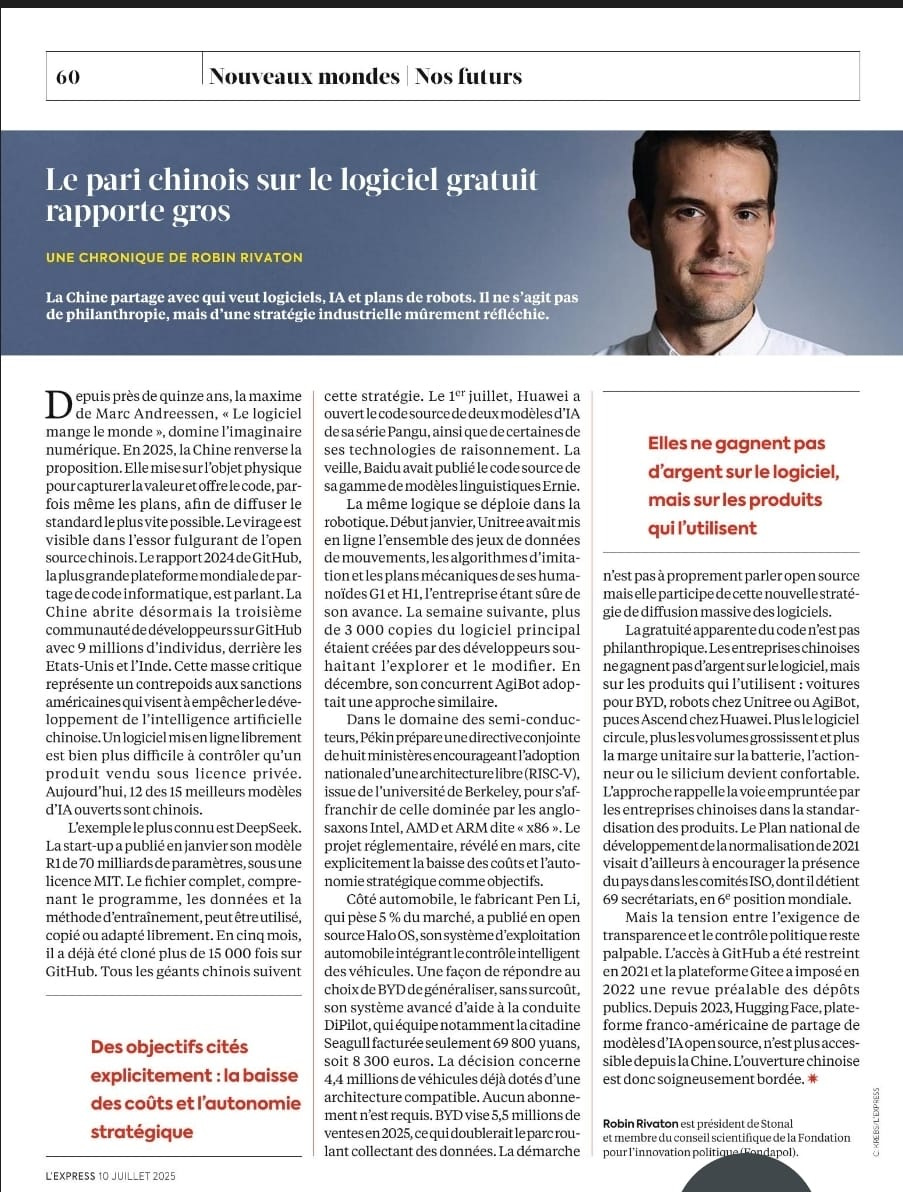For nearly fifteen years, Marc Andreessen’s maxim—“software eats the world”—has dominated the digital imagination. In 2025, China flips the script. It is betting on the physical object to capture value and giving away the code—sometimes even the blueprints—to propagate its standard as fast as possible. The pivot is stark in the meteoric rise of Chinese open source.
GitHub’s 2024 report shows China hosting the world’s third-largest developer community on the platform—9 million coders—behind only the United States and India. That critical mass blunts the effect of U.S. restrictions aimed at slowing China’s AI pipeline: a public repo is far harder to police than a commercial licence. Today, twelve of the fifteen leading open AI models are Chinese. The best-known case is DeepSeek, which on 25 January 2025 released its R1 model (70 billion parameters) under an MIT licence. The weights, inference code, and post-training methodology are all available—and have already been cloned 15,000 times on GitHub in five months. The giants are following suit. On Tuesday, 1 July, Huawei open-sourced two models from its Pangu series, plus parts of its reasoning stack—just a day after Baidu published the source code for its broad Ernie family of language models.
The same logic is playing out in robotics. In early January, Unitree put online the full kinematic datasets, imitation-learning algorithms, and mechanical schematics for its G1 and H1 humanoids, confident rivals wouldn’t catch up. Within a week, more than 3,000 forks of the core engine code appeared. In December, competitor AgiBot unveiled AgiBot World, a suite of foundation models and standardised benchmarks built notably from over one million trajectories recorded across a hundred humanoids.
In semiconductors, Beijing is preparing a joint directive from eight ministries to promote national adoption of RISC‑V, the open architecture born at UC Berkeley, as an escape hatch from the x86/Arm ecosystem dominated by Anglo-American champions Intel, AMD, and Arm. The draft regulation, revealed on 4 March, explicitly cites cost reduction and strategic autonomy as goals.
In automotive, manufacturer Pen Li, which holds roughly 5% of the market, has open-sourced Halo OS, its car operating system, including intelligent vehicle control. It’s a way to answer BYD’s decision to roll out its advanced driver-assistance system DiPilot across all 21 model lines at no extra cost—including the Seagull, priced at ¥69,800 (€8,276). The stack runs on DiPilot 600 (three lidars), DiPilot 300 (one lidar), and DiPilot 100 (camera only). The move covers 4.4 million vehicles already fitted with a compatible architecture. No subscription required. BYD is targeting 5.5 million sales in 2025, which would double the rolling fleet that feeds back data. This isn’t open source, but it springs from the same strategic logic.
The apparent free‑of‑charge code is anything but philanthropic. Chinese firms monetise the hardware layer: cars for BYD, robots for Unitree or AgiBot, Ascend chips for Huawei. The more freely the software circulates, the greater the unit volumes—and the fatter the margins on the battery, actuator, or silicon. This mirrors how Chinese companies have long approached standards-setting. The 2021 National Standardization Development Outline explicitly sought to boost the country’s presence in ISO committees, where China now holds 69 secretariats, sixth worldwide.
Tension between this demand for transparency and political control remains palpable. GitHub access was throttled in 2021, and the state-backed domestic platform Gitee imposed pre‑publication reviews for public repos in 2022. In 2023, Hugging Face—the Franco‑American platform for sharing open‑source AI models—became inaccessible from China.


